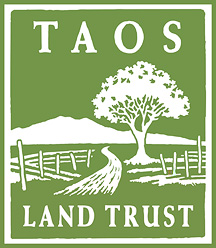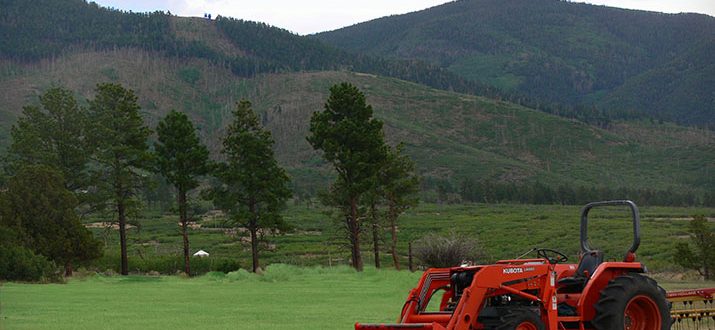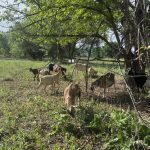To Farm or Not to Farm: Keeping Your Land Appraised as Agricultural
Actually, the rule is slightly more lenient. Your land must be in bona fide production at least 1 out of the last 3 years. The appraisers looking at land say they can tell if the land’s been worked in the last 10 years. Are the fences falling down? Is there a massive prairie dog town? Weeds? Sagebrush? Are the linderos (boundaries) to your main ditch clear and in good repair?
Someday doesn’t count. That’s the bottom line with Taos County. If you own land currently under the agricultural label, your fields must be in production. That means corner-to-corner, end-to-end. A couple of beehives in the back of your 2-acre lot won’t cut it. Nor do horses, which are considered pets unless you have a breeder’s license.
Why Now?
Over the past year or more, the county has been tracking down some of the over 6000 properties in Taos County alone that have been receiving the agricultural special valuation and thus paying lower taxes. So far, according to Nick Sanchez the Chief Appraiser, they’ve looked at about 1000 properties. Nearly 60 percent of those lost the special valuation, which means their taxes go up steeply. Of those that lost the valuation, 40 percent are putting land back into production.
People who love the land and want to preserve it from development are concerned. Many wonder how many landowners might have to sell out. If sold for development, these lands may never be farmed again in the future. (See link to Why Conserve Land).
“We need to preserve land because we’ll need land down the road to grow food to sustain us,” says Peggy Nelson, former District Judge and a commissioner on her acequia. Nelson is a member of the ART—Agricultural Resolution Team. This public group began meeting over a year ago and includes public agencies such as Taos County Agricultural Extension, non-profits like the Taos Land Trust and private landowners, as well as the Taos County Assessor’s Office. By coming together, they hope to find solutions that protect the agricultural tradition of the region and land with potential for future farms.
“Keep in mind,” says Sanchez, “the state shows only 918 farms listed in Taos County.” So what about the other 5000 plus?
Other states have been grappling with this kind of revised valuation for the last decade. In Colorado, the rule was so flexible that home developers and even resort owners were getting massive tax breaks on vacant land, according to a March 2011 article in the Denver Post in March 2011 <link>. Former Governor Dick Lamm was quoted as saying, “It allows people to tie up land under so-called agriculture and use it as a speculator’s device.” In New York state, woodlots fell under scrutiny some years ago and if you weren’t selling wood, then you weren’t a woodlot.
What Counts as Farming?
So if vacant land doesn’t qualify, then what does? Either you grow a crop or keep animals on minimum of an acre. The NM statute lists “plants, crops, trees, forest products, orchard crops, livestock, poultry, captive deer or elk, or fish.” Also, if you have a soil conservation agreement with a federal agency for which you are reimbursed, it counts.
A woman taking my call at Taos County Extension explained that she herself had to respond to a letter from the assessor’s office over her land. Because her grandfather grazes his cows there in the summer, she can claim the special valuation. But the rule is that animals have to be there more than 50 percent of the year. And she had to get a written lease signed by her grandfather. “You’ve got to show proof,” she explains. Keep records, take photos.
One animal unit is the minimum for agriculture. That could mean six goats or sheep. It could also be a single cow. Sanchez points out that in reality, the state insists on 80 acres or more per cow based on land carrying capacity. Many who run cattle move them from pasture to pasture, so that it adds up to the acreage needed or something close.
Crops: Old and New
The range of crops that can be grown in Taos County seems to be ever-expanding, even as the years of drought have also put many irrigated acres out of production. Alfalfa, adapted grasses, oats, clover, timothy and winter wheat all grow here. In fact, in the late 1800’s, this region was known as the breadbasket of the West and sent 130 different types of wheat to the Chicago World’s Fair in 1879!
“The easiest thing to do is to plant hay,” according to Mark Schuetz, owner of Watershed Landcare and a ranch and farm consultant, soil conservation educator, and former board member at Taos Soil and Water District. He also raises grassfed beef locally. “It’s hard to put in a vegetable garden over several acres,” he notes. Back-breaking and expensive.
Schuetz recommends growing a polyculture of mixed alfalfa and bunch grasses. The more diverse the native and adapted grasses, the more resilient the crop is to pests. You can fix nitrogen in the soil with clovers and alfalfa (legumes) and add oats as a nurse annual to the perennials like alfalfa.
Nick Sanchez likes vetch because you can grow it and let your animals feed while it is green and it won’t bloat them. Corn grows here, of course, pre-dating other agriculture as a reliable source of nutrition. At a sustainable conference put on by UNM-Taos recently, people heard Taos Pueblo musical artist Robert Mirabal talk about corn as an indigenous teacher of the spiritual aspect of farming.
New crops coming into favor in Northern New Mexico include the ancient Mayan grain quinoa. Hops is making a splash with the proliferation of microbreweries. Owners on one historic property in San Cristobal are planting goji berries, a high antioxidant health food which grows in a similar climate and elevation in China.
All of this takes water, of course. Something we haven’t had in steady supply for many years leading up to 2015’s parade of generous storms. That’s why the state legislature this year passed a new allowance for people to rest their land during a drought. Well, guess what? The drought is officially over even as the ink is drying on the new rule.
Renaissance of Growers
Call it tough love. As a consequence of new scrutiny, landowners around Taos are rediscovering their capacity for farming. Some hire out to put their acres back into use, where others lease their pastures for grazing. Tony Valdez with Taos County Extension recommends, “Go and talk to your neighbors.” Learning from those who still know what they’re doing is becoming increasingly important as an older generation leaves their ag lands to grandchildren who seem more interested in Youtube than in raising crops.
Keep in mind, if you lose your status, make an appeal to the Assessor and start pulling together documentation. Reach out to Tony Valdez at Taos County Extension and pick up their resource brochure with listings of all the agencies and many organizations that can help you get your land productive again.
Nobody seems very eager to witness the loss of farmlands. From eco-tourism and food production to the value of traditional ways of life, we all have a stake in keeping our land base healthy and within financial grasp of regular working families.
Lesli Allison, executive director of the Western Landowners Alliance based on Santa Fe, said Taos isn’t the only community facing the threat of fragmenting ag lands. Allison said her organization is working on a multi-state study on how state tax policies are affecting local economies. Allison said laws could be changed to relieve the stress on those who maintain open space rather than be forced to sell out.





